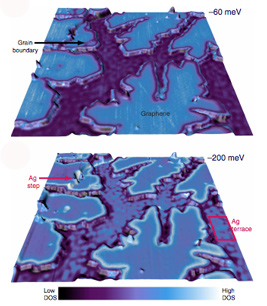Researchers Grow Graphene on Silver
New method could enable improved interfacing of graphene with other 2-D materials
Graphene, a one-atom-thick carbon layer with extraordinary conductivity and strength, holds promise for a range of applications, but to realize its potential scientists must perfect techniques to tune its properties. Growing graphene on silver in ultra-high vacuum could result in an exceptionally pristine sample, presenting opportunities for ultrafast electronics and advanced optics, but current methods for growing graphene on metals have been unsuccessful with silver.
Researchers from Northwestern University and Argonne National Laboratory have recently overcome these limitations, demonstrating the first growth of graphene on a single-crystal silver substrate. Their method could advance graphene-based optical devices and enable the interfacing of graphene with other two-dimensional materials.
The study is published today (Nov. 15) in the journal Nature Communications.
 “Silver is a widely used material to enhance optical properties,” said Northwestern’s Mark Hersam, a co-author of the paper. “More recently, graphene has emerged as a promising platform for optical technologies. With our recent development of a method for growing graphene on silver, we can now exploit the best attributes of both graphene and silver at the same time.”
“Silver is a widely used material to enhance optical properties,” said Northwestern’s Mark Hersam, a co-author of the paper. “More recently, graphene has emerged as a promising platform for optical technologies. With our recent development of a method for growing graphene on silver, we can now exploit the best attributes of both graphene and silver at the same time.”
Hersam is professor of materials science and engineering and Bette and Neison Harris Chair in Teaching Excellence at Northwestern’s McCormick School of Engineering and Applied Science and director of the Northwestern University Materials Research Center.
While graphene is conventionally grown on a metal surface by catalytically decomposing hydrocarbons at elevated temperatures, this method is ineffective for silver substrates because the substrates are chemically inert and have a relatively low melting point.
Using a graphite carbon source, the Northwestern and Argonne researchers were able to grow graphene by depositing atomic carbon, rather than a carbon-based molecular precursor, onto the substrate. The growth circumvented the need for a chemically active surface and allowed the researchers to realize graphene growth at lower temperatures.
“Graphene growth and transfer to a variety of substrates has allowed graphene to transform countless scientific fields,” said Brian Kiraly, a Northwestern graduate student in materials science and engineering who worked on the research with Hersam and Nathan Guisinger, a staff scientist at Argonne.
 “However, conventional techniques lead to contamination issues and are not compatible with the ultra-clean vacuum environments required for the growth of the latest 2-D materials,” he said. “By growing graphene directly on silver under vacuum, we provide an atomically pristine surface for advanced graphene-based technologies.”
“However, conventional techniques lead to contamination issues and are not compatible with the ultra-clean vacuum environments required for the growth of the latest 2-D materials,” he said. “By growing graphene directly on silver under vacuum, we provide an atomically pristine surface for advanced graphene-based technologies.”
The researchers also found the graphene they grew was electronically decoupled from the underlying silver substrate, allowing the intrinsic properties of graphene to be studied and exploited directly on the growth substrate; this characteristic has not been previously observed with graphene grown on other metals. The researchers observed unique wave-like electron scattering at the graphene’s edges that had previously been observed only on insulating substrates.
Recent work on integrating graphene with other 2-D materials -- a step vital for the development of graphene-based circuits and other technologies -- has yielded both enhancements of graphene’s properties and the emergence of new properties distinct from isolated graphene. The development of graphene on silver enables researchers to probe graphene interfaces with a new 2-D material, silicene, which is almost exclusively grown on silver.
The paper is titled “Solid Source Growth and Atomic-Scale Characterization of Graphene on Ag(111).” In addition to Hersam, Guisinger and Kiraly (first author), postdoctoral researcher Erin Iski, graduate student Andy Mannix, and Argonne engineer Brandon Fisher co-authored the work.
The research was funded by the Department of Energy SISGR grant, Department of Energy Office of Science and the National Science Foundation.